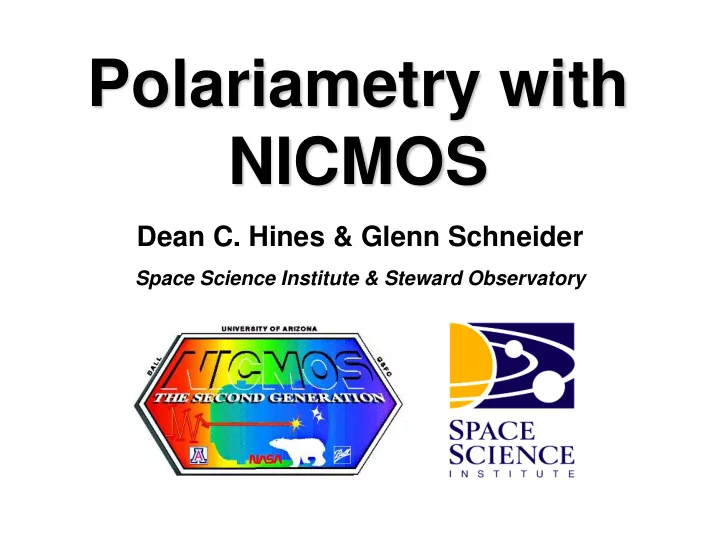

Polariametry with NICMOS Dean C. Hines & Glenn Schneider Space Science Institute & Steward Observatory
Thermo-Vac Tests POL0S POL120S POL240S (Background Subtracted) 4000 Mean Counts/sec 2000 0 POL0L POL120L POL240L (Background Subtracted) 6000 Mean Counts/sec 4000 2000 CIRCE Polarized NICMOS Light Source (p=100%) Polarizer 0 0 50 100 150 200 Position Angle of Incoming 100% Polarized Light (Þ) Space Science Institute 10/2005 DCH-2
Thermo-Vac Tests • Unique polarizing efficiencies ( ε = 100% for ideal polarizers). – POL0S highest at ε = 97% – POL120S lowest at ε = 48% • Polarization efficiency constant over FOV. • Angular offsets differ from nominal (120˚) by arbitrary (but accurately measured) amounts. • Instrumental polarization caused by reflections off the mirrors in the optical train within NICMOS is small (≤ 1%). Space Science Institute 10/2005 DCH-3
Thermo-Vac Tests • Grisms act as partial linear polarizers, with G206 producing the largest intensity variations ( ∆ I ≈ 5%) for completely polarized light. – Effect proportional to incoming polarized signal and position angle. – Only important for highly polarized objects. • Grisms cannot be used with either the NIC1 or NIC2 polarizers and are thus unsuitable for spectropolarimetry. Space Science Institute 10/2005 DCH-4
Polarimetry Algorithm ( POLARIZE ) At any pixel in an image, the observed signal from a polarized source of total intensity I and linear Stokes parameters Q & U measured through the k th polarizer oriented at position angle φ k is: S k = A k I + ε k (B k Q +C k U) A k = t k /2(1+l k ), B k = A k cos(2 φ k ), C k = A k sin(2 φ k ) ε k is the polarizing efficiency, t k is the fraction of light transmitted through the polarizer for a 100% polarized input aligned with the polarizer axis l k is the "leak" term — the fraction of light transmitted through the polarizer (exclusive of that involved in t k ) when the incident beam is polarized perpendicular to the axis of the polarizer. ε k =(1- l k )/(1+ l k ). Hines, Schmidt & Schneider (2000), Generalized treatment of N- polarizers by Sparks & Axon (1999). Space Science Institute 10/2005 DCH-5
Stokes Uncertainties Space Science Institute 10/2005 DCH-6
Stokes Uncertainties • Three Regimes: Read Noise, Photon (C) Noise, Flat Field Residuals • σ p ≈ 1/<S/N> ≈ sqrt(2/C) per image in photon regime • Require p/ σ p > 4, for accurate polarimetry • No formal debiasing technique is endorsed or used in reduction • Errors in θ standard, but must rectify images Space Science Institute 10/2005 DCH-7
Ground-Truth Results essentially identical when NICMOS data smoothed ( in Flux Weighted Stokes ) (a) (b) NICMOS: P(max) = 78% KPNO/COB: P(max) = 50% Space Science Institute 10/2005 DCH-8
NIC1 - The Egg Nebula Total Image of CRL 2688 Data courtesy of R. Sahai Space Science Institute 10/2005 DCH-9
NIC1 Ghosts Images • Prominent Ghost Images • Differ in each polarizer • Causes p = 100% regions • Remedy – – multiple spacecraft roll angles – Multiple epochs possible Space Science Institute 10/2005 DCH-10
NCS Cycles vs. Cycles 7 & 7N • Some change evident in null observations • Adjusted “A” coefficient ( ∆ A ≈ 1%) • Change appears to mimic a ~1-2% (in p%) effect • New coefficient tables published in Handbook • No obvious problem for objects polarized p ≥ 10% • Two Gyro Mode should have minimal effect on direct imaging polarimetry Space Science Institute 10/2005 DCH-11
Coronagraphic Polarimetry • New mode tested in Cycle 12 • Offered in Cycle 14 • Successful combination of NIC2 coronagraph with polarizers • Advantage over direct coronagraphy – Detect polarized emission near bright point-source » Circumstellar Disks » Scattering regions around AGNs – PSF is obtained simultaneously – PSF-subtraction “built-in” Space Science Institute 10/2005 DCH-12
Coronagraphic Polarimetry Space Science Institute 10/2005 DCH-13
Coronagraphic Polarimetry Space Science Institute 10/2005 DCH-14
Coronagraphic Polarimetry Radius (Arcsec) 0.5 1 1.5 2 2.5 3 25 20 Polarization (%) 15 10 5 0 5 10 15 20 25 30 35 40 Radius (Pixels) Space Science Institute 10/2005 DCH-15
Coronagraphic Polarimetry Radius (arcsec) 0.5 1 1.5 2 2.5 3 V30_I V30_P*I V31_I V31_P*I V60_I Total Intensity (I) V60_P*I Intensity (Arbitraty Units) V61_I 10 V61_P*I I_median P*I_median 1 Polarized Intensity (P*I) 0.1 5 10 15 20 25 30 35 40 Radius (Pixels) Space Science Institute 10/2005 DCH-16
Two Gyro Mode Two Gyro Mode tests from Schneider et al. 2005 (NICMOS ISR 2005-001) Direct In Coronagraph Orbit 1 - Orbit 2 Space Science Institute 10/2005 DCH-17
Two Gyro Mode • Jitter <~ 7-8 mas implying performance comparable to three gyro mode • Single orbit roll not available, but doesn’t affect polarimetry • Calibration of 2 µ m pol filters not yet done • An unpolarized standard star should be observed in addition to the primary target object Space Science Institute 10/2005 DCH-18
NICMOS Polarimetry Science • Active Galaxies – Centaurus A – Capetti et al. 2000 – Cygnus A – Tadhunter et al. 2000 – NGC 1068 – Simpson et al. 2002 • Proto-Planetary Nebulae – CRL2688 (Egg Nebula) – Sahai et al. 1998, Weintraub et al. 2000 – CIT 6 – Schmidt, Hines & Swift 2002 – Eta Car – King et al. 2002 – Polarization of PPN – Su et al. 2003, Ueta et al. 2005 • Young Stellar Objects – GG Tau – Silber et al. 2000 – AFGL437 – Meakin, Hines & Thompson 2005 • Solar System ( Io & Titon) Space Science Institute 10/2005 DCH-19
NICMOS Polarimetry Science Ueta et al. 2005 Space Science Institute 10/2005 DCH-20
NICMOS Polarimetry Science Silber et al. 2000 Space Science Institute 10/2005 DCH-21
NICMOS Continues to Deliver High Fidelity (Imaging & Coronagraphic) Polarimetry Combined with ACS, HST Offers Imaging Polarimetry Capability from UV - NIR
Backup Slides
Coronagraphic Polarimetry Space Science Institute 10/2005 DCH-24
Recommend
More recommend